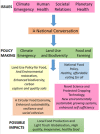Sustainable production of healthy, affordable food in the UK: The pros and cons of plasticulture
- PMID: 36582471
- PMCID: PMC9787550
- DOI: 10.1002/fes3.404
Sustainable production of healthy, affordable food in the UK: The pros and cons of plasticulture
Abstract
An evolving green agenda as the UK seeks to achieve 'net zero' in greenhouse gas emissions by 2050, coupled with our new trading relationship with the European Union, is resulting in new government policies, which will be disruptive to Britain's traditional food and farming practices. These policies encourage sustainable farming and land-sparing to restore natural habitats and will provide an opportunity to address issues such as high emissions of GHGs and dwindling biodiversity resulting from many intensive agricultural practices. To address these and other food challenges such as global conflicts and health issues, Britain will need a revolution in its food system. The aim of this paper is to make the case for such a food revolution where additional healthy food for the UK population is produced in-country in specialised production units for fruits and vegetables developed on sites previously considered unsuitable for crop production. High crop productivity can be achieved in low-cost controlled environments, making extensive use of novel crop science and modern controlled-environment technology. Such systems must be operated with very limited environmental impact. In recent years, growth in the application of plasticulture in UK horticulture has driven some increases in crop yield, quality and value. However, the environmental cost of plastic production and plastic pollution is regarded as a generational challenge that faces the earth system complex. The distribution of plastic waste is ubiquitous, with a significant pollution load arising from a range of agricultural practices. The primary receptor of agriplastic pollution is agricultural soil. Impacts of microplastics on crop productivity and quality and also on human health are only now being investigated. This paper explores the possibility that we can mitigate the adverse environmental effects of agriplastics and thereby exploit the potential of plasticulture to enhance the productivity and positive health impact of UK horticulture.
Keywords: crop production; food security; growing systems; plastic pollution; plasticulture; protected cropping.
© 2022 The Authors. Food and Energy Security published by John Wiley & Sons Ltd.
Conflict of interest statement
9The authors declare that the research was conducted without any commercial or financial influence that could be interpreted as a potential conflict of interest.
Figures



References
-
- Ahamed, M. S. , Guo, H. , & Tanino, K. (2019). Energy saving techniques for reducing the heating cost of conventional greenhouses. Biosystems Engineering, 178, 9–33. 10.1016/j.biosystemseng.2018.10.017 - DOI
-
- APE . (2019). The European Plasticulture Strategy: A contribution to the agri‐plastic waste management . Retrieved from https://apeeurope.eu/wp‐content/uploads/2021/10/EPS‐EPA‐2021.pdf
-
- Aznar‐Sánchez, J. A. , Velasco‐Muñoz, J. F. , García‐Arca, D. , & López‐Felices, B. (2020). Identification of opportunities for applying the circular economy to intensive agriculture in Almería (South‐East Spain). Agronomy, 10(10), 1499. 10.3390/agronomy10101499 - DOI
-
- Balmford, A. (2021). Concentrating vs. spreading our footprint: How to meet humanity's needs at least cost to nature. Journal of Zoology, 315(2), 79–163. 10.1111/jzo.12920 - DOI
-
- Barfoots . (2022). Retrieved January 13, 2022, from https://www.barfoots.com/
Publication types
LinkOut - more resources
Full Text Sources
Miscellaneous
